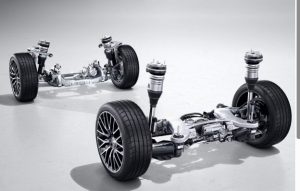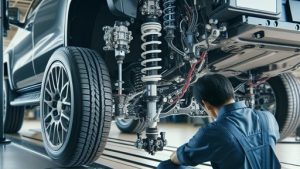Suspension systems are vital to a vehicle’s performance, safety, and ride comfort. As vehicle technology advances, many drivers are considering the transition from traditional spring-based suspensions to more sophisticated air suspension systems. But is it worth the upgrade?
Whether you’re a daily driver, performance enthusiast, or fleet operator, understanding the strengths and weaknesses of both air suspensions and traditional springs will help you make the right choice. This article compares the two systems, breaking down their core differences in function, cost, durability, and driving performance.
What Is a Traditional Spring Suspension?
Traditional suspensions rely on coil springs or leaf springs to support the vehicle’s weight, absorb road shocks, and maintain ride height. These springs compress and expand as needed to smooth out road imperfections and maintain control.
Types of Traditional Springs:
-
Coil Springs: Common in passenger cars; made of wound steel coils.
-
Leaf Springs: Multi-layered flat metal strips, often used in trucks and vans.
Pros:
-
Simple and durable design
-
Lower cost of repair and replacement
-
Proven performance over decades
Cons:
-
Fixed ride height and stiffness
-
Less adaptable to load variations
-
Can feel harsh over uneven roads
What Is an Air Suspension System?

An air suspension replaces steel springs with air springs (rubber bladders filled with compressed air), offering automatic control over ride height and stiffness. A compressor, air tank, valves, and ECU (Electronic Control Unit) adjust the air pressure to suit driving conditions or user preferences.
Common Air Suspension Components:
-
Air springs (airbags)
-
Air compressor and tank
-
Ride height sensors
-
Electronic control unit (ECU)
-
Solenoid valves and lines
Pros:
-
Adjustable ride height and stiffness
-
Superior comfort and shock absorption
-
Automatic load leveling
-
Enhanced performance handling
Cons:
-
Higher initial and maintenance cost
-
More complex and prone to air leaks
-
Repairs often require specialist knowledge
Comparison Table: Air Suspension vs. Traditional Springs
| Feature | Air Suspension | Traditional Springs |
|---|---|---|
| Ride Comfort | Very smooth, adaptive | Moderate, depends on tuning |
| Adjustability | Height and stiffness adjustable | Fixed characteristics |
| Load Handling | Automatically adjusts for load | May sag under heavy loads |
| Durability | Moderate (rubber wears out) | High (steel components last longer) |
| Maintenance Cost | High | Low |
| Failure Risk | Leaks, compressor issues possible | Rare mechanical failure |
| Performance Handling | Precise, programmable | Stable but less dynamic |
| Cold Weather Resistance | Needs care (air can freeze) | Excellent |
| Installation Complexity | Complex, involves electronics | Straightforward |
List: When to Choose Each System
Choose Air Suspension If You:
-
Want to adjust ride height for comfort or off-roading
-
Frequently carry varying loads (trailers, cargo)
-
Prioritize comfort and modern features
-
Participate in motorsports or show builds
-
Drive a luxury or high-performance vehicle
Choose Traditional Springs If You:
-
Want reliable, low-maintenance suspension
-
Have a tight budget
-
Drive a commercial vehicle or work truck
-
Don’t need ride height adjustments
-
Prefer a simple, mechanical system
Key Differences Explained
1. Ride Comfort
Air suspensions offer a luxury-level smooth ride. The adjustable air pressure absorbs bumps and road irregularities more effectively than metal springs. Traditional springs can offer good comfort, but not the same plushness, especially on rough terrain.
2. Load-Leveling
Air suspension shines in this area. Whether you’re towing a trailer or carrying heavy equipment, the system automatically levels your vehicle. Traditional springs can sag under load unless upgraded with additional components (like helper springs).
3. Adjustability
Air suspensions can raise or lower the vehicle on demand. This is useful for:
-
Lowering for highway aerodynamics or easier loading
-
Raising for off-road clearance
-
Auto-leveling when parked on uneven ground
Traditional springs require physical replacement or modification to change ride height or stiffness.
4. Performance and Handling
With real-time stiffness control and low center-of-gravity settings, air suspensions can improve handling in sporty driving conditions. Traditional springs offer predictable handling but don’t adapt dynamically.
Cost and Maintenance Comparison
| Aspect | Air Suspension | Traditional Springs |
|---|---|---|
| Initial Cost | High | Low |
| Routine Maintenance | Compressor/o-rings | Minimal (visual checks) |
| Common Repairs | Leaks, sensors, relays | Spring or bushing wear |
| DIY-Friendly | Moderate to difficult | Easy to moderate |
| Lifespan | 5–10 years (airbags) | 10–20 years |
Applications and Use Cases
| Vehicle Type | Recommended System |
|---|---|
| Luxury Sedan (e.g. Audi A8) | Air Suspension |
| Work Truck / Van | Traditional (leaf springs) |
| Off-Road SUV (Jeep, Land Rover) | Air Suspension for clearance |
| Budget Daily Driver | Traditional Springs |
| Custom Show Car | Air Suspension |
| Sports Coupe | Coil Springs or Air |
Upgrading Your Suspension

If you’re considering an upgrade or replacement, assess your driving habits, load requirements, and climate. Air suspensions offer more comfort and control, but require more upkeep. Traditional springs are rugged and reliable, ideal for simpler applications.
Buy Air Suspension online — Choose from complete kits, replacement parts, compressors, and electronic control modules suitable for various vehicle types.
Final Thoughts
Both air suspension and traditional springs have their place in modern vehicles.
-
Air suspension delivers unmatched comfort, versatility, and precision, making it ideal for premium vehicles, adjustable setups, and variable load conditions.
-
Traditional springs, on the other hand, offer long-lasting reliability, low maintenance costs, and simplicity — a tried-and-true solution for millions of drivers.
Ultimately, the best system depends on how you drive, what you carry, and how much tech you want to manage. If comfort and customization are your priorities, air suspension might be worth the investment. But if durability and budget-friendliness matter more, traditional springs are hard to beat.